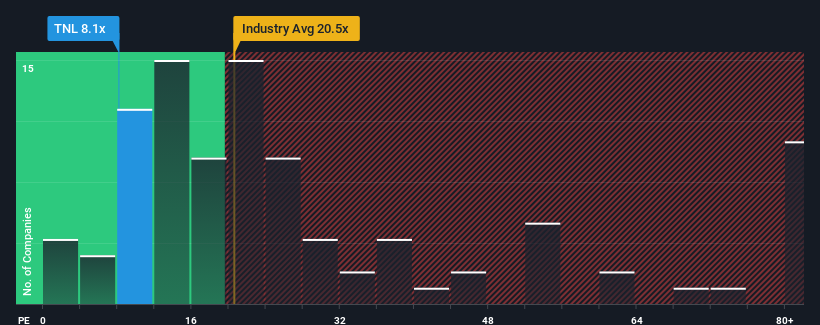- United States
- /
- Hospitality
- /
- NYSE:TNL
Travel + Leisure Co. (NYSE:TNL) Might Not Be As Mispriced As It Looks

With a price-to-earnings (or "P/E") ratio of 8.1x Travel + Leisure Co. (NYSE:TNL) may be sending very bullish signals at the moment, given that almost half of all companies in the United States have P/E ratios greater than 17x and even P/E's higher than 33x are not unusual. Although, it's not wise to just take the P/E at face value as there may be an explanation why it's so limited.
With its earnings growth in positive territory compared to the declining earnings of most other companies, Travel + Leisure has been doing quite well of late. One possibility is that the P/E is low because investors think the company's earnings are going to fall away like everyone else's soon. If you like the company, you'd be hoping this isn't the case so that you could potentially pick up some stock while it's out of favour.
Check out our latest analysis for Travel + Leisure

What Are Growth Metrics Telling Us About The Low P/E?
Travel + Leisure's P/E ratio would be typical for a company that's expected to deliver very poor growth or even falling earnings, and importantly, perform much worse than the market.
Taking a look back first, we see that the company managed to grow earnings per share by a handy 4.2% last year. Still, EPS has barely risen at all in aggregate from three years ago, which is not ideal. So it appears to us that the company has had a mixed result in terms of growing earnings over that time.
Turning to the outlook, the next year should generate growth of 14% as estimated by the seven analysts watching the company. That's shaping up to be materially higher than the 10% growth forecast for the broader market.
In light of this, it's peculiar that Travel + Leisure's P/E sits below the majority of other companies. It looks like most investors are not convinced at all that the company can achieve future growth expectations.
What We Can Learn From Travel + Leisure's P/E?
It's argued the price-to-earnings ratio is an inferior measure of value within certain industries, but it can be a powerful business sentiment indicator.
Our examination of Travel + Leisure's analyst forecasts revealed that its superior earnings outlook isn't contributing to its P/E anywhere near as much as we would have predicted. When we see a strong earnings outlook with faster-than-market growth, we assume potential risks are what might be placing significant pressure on the P/E ratio. It appears many are indeed anticipating earnings instability, because these conditions should normally provide a boost to the share price.
You should always think about risks. Case in point, we've spotted 3 warning signs for Travel + Leisure you should be aware of, and 1 of them shouldn't be ignored.
You might be able to find a better investment than Travel + Leisure. If you want a selection of possible candidates, check out this free list of interesting companies that trade on a low P/E (but have proven they can grow earnings).
Valuation is complex, but we're here to simplify it.
Discover if Travel + Leisure might be undervalued or overvalued with our detailed analysis, featuring fair value estimates, potential risks, dividends, insider trades, and its financial condition.
Access Free AnalysisHave feedback on this article? Concerned about the content? Get in touch with us directly. Alternatively, email editorial-team (at) simplywallst.com.
This article by Simply Wall St is general in nature. We provide commentary based on historical data and analyst forecasts only using an unbiased methodology and our articles are not intended to be financial advice. It does not constitute a recommendation to buy or sell any stock, and does not take account of your objectives, or your financial situation. We aim to bring you long-term focused analysis driven by fundamental data. Note that our analysis may not factor in the latest price-sensitive company announcements or qualitative material. Simply Wall St has no position in any stocks mentioned.
About NYSE:TNL
Travel + Leisure
Provides hospitality services and travel products in the United States and internationally.
Undervalued average dividend payer.
Similar Companies
Market Insights
Community Narratives



